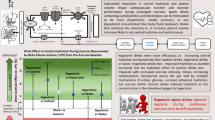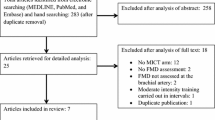Abstract
We evaluated the effect of exercise-induced hyperthermia (EIH) on autonomic nervous system (ANS) function in the early (<80 min) and late (24 and 48 h) stages of recovery. Eight males underwent three repeated 6 min 70° head-up tilts (HUT1, HUT2 and HUT3), each separated by 10-min supine rest in a non-exercise/non-heat stress control state (NHS). On a separate day, three 6 min 70° HUT were performed following EIH (esophageal temperature ≥40°C) and repeated after 24 and 48 h of recovery. Heart rate, stroke volume (SV), mean arterial pressure and cardiac output (\( \dot{Q} \)) were evaluated during the last min prior to a change in posture. Responses to 70° HUT were compared to the same challenge performed without prior exercise and under a NHS condition. Relative to NHS, \( \dot{Q} \) was maintained during the repeated HUT’s following EIH, despite significant reductions in SV and sustained elevations in esophageal temperature (p < 0.05). The preserved \( \dot{Q} \) appears to be due to increased HR (HUT1: NRS = 76 ± 3 beats min−1, EIH = 126 ± 6 beats min−1) stemming from modulation of the ANS toward sympathetic dominance. Parasympathetic withdrawal was evidenced by a reduction in root mean squared successive difference (i.e., HUT1: NHS = 66 ± 12 ms, EIH = 9 ± 1 ms) of heart rate variability and paralleled by a reduction in baroreceptor sensitivity for all HUT’s following EIH (p < 0.05). Despite significant modulation in ANS activity, Q is maintained and participants do not become orthostatic intolerant/syncopal during the short-term recovery period following EIH. Normal ANS and cardiovascular function is restored following 24 h of recovery.


Similar content being viewed by others
References
Ahmad S, Ramsay T, Huebsch L, Flanagan S, McDiarmid S, Batkin I, McIntyre L, Sundaresan SR, Maziak DE, Shamji FM, Hebert P, Fergusson D, Tinmouth A, Seely AJ (2009) Continuous multi-parameter heart rate variability analysis heralds onset of sepsis in adults. PLoS One 4:e6642
Armstrong LE, Casa DJ, Millard-Strafford M, Moran DS, Pyne SW, Roberts WO (2007) Exertional heat illness during training and competition. Med Sci Sports Exerc 3:556–572
Armstrong RG, Seely AJ, Kilby D, Journeay SW, Kenny GP (2010) Cardiovascular and thermal responses to repeated head-up tilts following exercise-induced heat stress. Aviat Space Environ Med 81:646–653
Bartholomew K, O’Brien BJ, Gill ND (2005) Plasma volume expansion 24-hours post exercise: effect of doubling the volume of replacement fluid. J Sports Sci Med 4:179–184
Bernardi L, Passino C, Robergs R, Appenzeller O (1997) Acute and persistent effects of a 46-kilometer wilderness trail run at altitude: cardiovascular autonomic modulation and baroreflexes. Cardiovasc Res 34:273–280
Berry NM, Rickards CA, Newman DG (2006) Acute cardiovascular adaptation to 10 consecutive episodes of head-up tilt. Aviat Space Environ Med 77:494–499
Brenner IK, Thomas S, Shephard RJ (1997) Spectral analysis of heart rate variability during heat exposure and repeated exercise. Eur J Appl Physiol 76:145–156
Brenner IK, Thomas S, Shephard RJ (1998) Autonomic regulation of the circulation during exercise and heat exposure: inferences from heart rate variability. Sports Med 2:85–99
Butler GC, Yamamoto Y, Hughson RL (1994) Heart rate variability to monitor autonomic nervous system activity during orthostatic stress. J Clin Pharmacol 34:558–562
Fessel J, Robertson D (2006) Orthostatic hypertension: when pressor reflexes overcompensate. Nat Clin Pract Nephrol 2:424–431
Flouris AD, Cheung SS (2009) Influence of thermal balance on cold-induced vasodilation. J Appl Physiol 106:1264–1271
Furlan R, Piazza S, Dell’Orto S, Gentile E, Cerutti S, Pagani M, Malliani A (1993) Early and late effects of exercise and athletic training on neural mechanisms controlling heart rate. Cardiovasc Res 27:482–488
Gagnon D, Jay O, Reardon FD, Journeay WS, Kenny GP (2008) Hyperthermia modifies the nonthermal contribution to postexercise heat loss responses. Med Sci Sports Exerc 40:513–522
Halliwill JR (2001) Mechanisms and clinical implications of post-exercise hypotension in humans. Exerc Sport Sci Rev 29:65–70
Hautala A, Tulppo MP, Makikallio TH, Laukkanen R, Nissila S, Huikuri HV (2001) Changes in cardiac autonomic regulation after prolonged maximal exercise. Clin Physiol 21:238–245
Hubbard RW (1990) Heatstroke pathophysiology: the energy depletion model. Med Sci Sports Exerc 1:19–28
Iellamo F (2001) Neural mechanisms of cardiovascular regulation during exercise. Auton Neurosci 90:66–75
Jellema WT, Imholz BP, van Goudoever J, Wesseling KH, van Lieshout JJ (1996) Finger arterial versus intrabrachial pressure and continuous cardiac output during head-up tilt testing in healthy subjects. Clin Sci (Lond) 91:193–200
Kenny GP, Jay O, Journeay WS (2007) Disturbance of thermal homeostasis following dynamic exercise. Appl Physiol Nutr Metab 32:818–831
Kenny GP, Gagnon D, Shiff D, Armstrong R, Journeay WS, Kilby D (2010) Influence of nonthermal baroreceptor modulation of heat loss responses during uncompensable heat stress. Eur J Appl Physiol 108:541–548
Loimaala A, Huikuri H, Oja P, Pasanen M, Vuori I (2000) Controlled 5-mo aerobic training improves heart rate but not heart rate variability or baroreflex sensitivity. J Appl Physiol 89:1825–1829
Niemela TH, Kiviniemi AM, Hautala AJ, Salmi JA, Linnamo V, Tulppo MP (2008) Recovery pattern of baroreflex sensitivity after exercise. Med Sci Sports Exerc 40:864–870
Nybo L (2008) Hyperthermia and fatigue. J Appl Physiol 104:871–878
Ogoh S, Fisher JP, Dawson EA, White MJ, Secher NH, Raven PB (2005) Autonomic nervous system influence on arterial baroreflex control of heart rate during exercise in humans. J Physiol 566:599–611
Parati G, Casadei R, Groppelli A, Di Rienzo M, Mancia G (1989) Comparison of finger and intra-arterial blood pressure monitoring at rest and during laboratory testing. Hypertension 13:647–655
Parekh A, Lee CM (2005) Heart rate variability after isocaloric exercise bouts of different intensities. Med Sci Sports Exerc 37:599–605
Penaz J (1975) Current photoelectric recording of blood flow through the finger. Cesk Fysiol 24:349–352
Proulx CI, Ducharme MB, Kenny GP (2006) Safe cooling limits from exercise-induced hyperthermia. Eur J Appl Physiol 96:434–445
Rowell LB, Wyss CR, Brengelmann GL (1973) Sustained human skin and muscle vasoconstriction with reduced baroreceptor activity. J Appl Physiol 34:639–643
Seely AJ, Macklem PT (2004) Complex systems and the technology of variability analysis. Crit Care 8:R367–R384
Siri WE (1956) The gross composition of the body. Adv Biol Med Phys 4:239–280
Skrapari I, Tentolouris N, Perrea D, Bakoyiannis C, Papazafiropoulou A, Katsilambros N (2007) Baroreflex sensitivity in obesity: relationship with cardiac autonomic nervous system activity. Obesity (Silver Spring) 15:1685–1693
Sugawara J, Tanabe T, Miyachi M, Yamamoto K, Takahashi K, Iemitsu M, Otsuki T, Homma S, Maeda S, Ajisaka R, Matsuda M (2003) Non-invasive assessment of cardiac output during exercise in healthy young humans: comparison between Modelflow method and Doppler echocardiography method. Acta Physiol Scand 179:361–366
Task Force of the European Society of Cardiology and the North American Society of Pacing and Electrophysiology (1996) Heart rate variability. Standards of measurement, physiological interpretation, and clinical use. Eur Heart J 17:354–381
Terziotti P, Schena F, Gulli G, Cevese A (2001) Post-exercise recovery of autonomic cardiovascular control: a study by spectrum and cross-spectrum analysis in humans. Eur J Appl Physiol 84:187–194
Van Ravenswaaij-Arts CMA, Kollee LAA, Hopman JCW, Stoelinga GBA, Van Geijn HP (1993) Heart rate variability. Ann Intern Med 118:436–447
Westerhof BE, Gisolf J, Karemaker JM, Wesseling KH, Secher NH, van Lieshout JJ (2006) Time course analysis of baroreflex sensitivity during postural stress. Am J Physiol Heart Circ Physiol 291:H2864–H2874
World Health Organization (2007) International statistical classification of diseases and related health problems, 10th edn. World Health Organization Press, Switzerland
Yamamoto S, Iwamoto M, Inoue M, Harada N (2007) Evaluation of the effect of heat exposure on the autonomic nervous system by heart rate variability and urinary catecholamines. J Occup Health 49:199–204
Acknowledgments
This research was supported by the Natural Sciences and Engineering Research Council (RGPIN-298159-2004 and RGPIN-298159-2009) and Leaders Opportunity Fund from the Canada Foundation for Innovation (grants held by Dr. Glen Kenny). Ms. Rachel Armstrong was supported by a Natural Sciences and Engineering Research Council Canada Graduate Scholarship. Dr. Glen Kenny was supported by a University of Ottawa Research Chair.
Conflict of interest
Ms. R. Armstrong has no conflicts of interest to disclose. Mr. Saif Ahmad has no conflicts of interest to disclose. Dr. A. Seely founded Therapeutic Monitoring Systems in order to commercialize patented Continuous Individualized Monitoring Variability Analysis (CIMVA) technology, with the objective of delivering variability-directed clinical decision support to improve quality and efficiency of care. Dr. G. Kenny has no conflicts of interest to disclose.
Author information
Authors and Affiliations
Corresponding author
Additional information
Communicated by Narihiko Kondo.
Rights and permissions
About this article
Cite this article
Armstrong, R.G., Ahmad, S., Seely, A.J. et al. Heart rate variability and baroreceptor sensitivity following exercise-induced hyperthermia in endurance trained men. Eur J Appl Physiol 112, 501–511 (2012). https://doi.org/10.1007/s00421-011-1989-x
Received:
Accepted:
Published:
Issue Date:
DOI: https://doi.org/10.1007/s00421-011-1989-x




